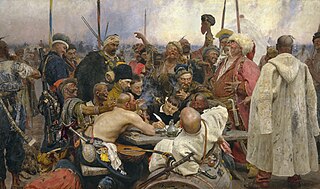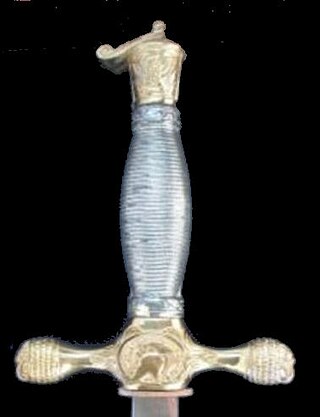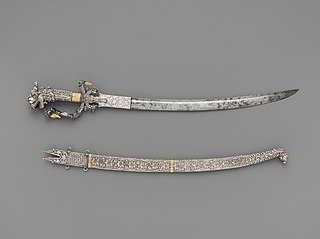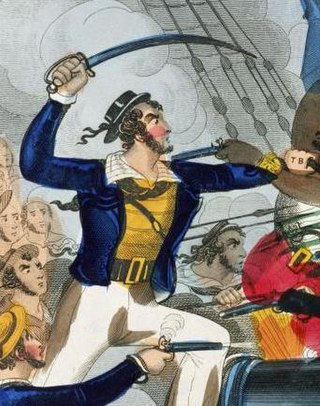A sabre or (American English)saber is a type of backsword with a curved blade associated with the light cavalry of the early modern and Napoleonic periods. Originally associated with Central European cavalry such as the hussars, the sabre became widespread in Western Europe during the Thirty Years' War. Lighter sabres also became popular with infantry of the early 17th century. In the 19th century, models with less curving blades became common and were also used by heavy cavalry.

The talwar, also spelled talwaar and tulwar, is a type of curved sword or sabre from the Indian subcontinent.
Szabla is the Polish word for sabre.

The shashka or shasqua is a kind of North Caucasian sabre; a single-edged, single-handed, and guardless sabre. The comparatively gentle curve of a shashka blade puts the weapon midway between a typically curved sabre and a straight sword, effective for both cutting and thrusting.

A kalis is a type of Philippine sword. The kalis has a double-edged blade, which is commonly straight from the tip but wavy near the handle. Kalis exists in several variants, either with a fully straight or fully wavy blade. It is similar to the Javanese keris, but differs in that the kalis is a sword, not a dagger. It is much larger than the keris and has a straight or slightly curved hilt, making it a primarily heavy slashing weapon.

The Pattern 1908 cavalry trooper's sword was the last service sword issued to the cavalry of the British Army. It has been called the most effective cavalry sword ever designed, although its introduction occurred as swords finally became obsolete as military weapons. In use, it, like other thrust-based cavalry swords, is best described as a one-handed lance, due to its complete lack of utility for anything but the charge. In fact, the closely related US Model 1913 Cavalry Saber was issued with only a saddle scabbard, as it was not considered to be of much use to a dismounted cavalryman. Colonial troops, who could expect to engage in melee combat with opposing cavalry frequently carried cut and thrust swords either instead of, or in addition to, the P1908/1912.

The Gothic hilted swords are a family of swords carried by officers and some NCOs of the British Army between 1822 and the present day. They are primarily infantry swords, although they were also regulation pattern for some other officers such as surgeons and staff officers. The term "Gothic hilt" is derived from a perceived similarity between the curved bars of the guard and the arches found in Gothic architecture. They are elegant aesthetically pleasing weapons, although considered by some to be mediocre fighting swords. The weapon and its variants had a very long service life.

The Pattern 1796 British infantry officer's sword was carried by officers of the line infantry in the British Army between 1796 and the time of its official replacement with the gothic hilted sword in 1822. This period encompassed the whole of the Napoleonic Wars.

The Marine Corps noncommissioned officer's sword is a sword worn by noncommissioned officers (NCOs) and staff noncommissioned officers (SNCOs) of the United States Marine Corps. The NCO sword was adopted in 1859 and is patterned after the United States Army's foot officers' sword of 1850. The M1859 NCO sword continues service today as the Marine Corps drill and ceremonial sword. The sword's use is restricted by regulation to ceremonial occasions by an NCO or Staff NCO in charge of troops under arms or at weddings and wedding receptions where at least one of those being married is in uniform and has the rank of Corporal or higher.

The Model 1913 Cavalry Sword, commonly referred to as the Patton Saber, was a cavalry sword designed for the U.S. Army by Second Lieutenant George S. Patton Jr. in 1913. Patton suggested the revision from a curved cutting sword to a straight thrusting sword style of attack, following his extensive training in France.

The Model 1840 Cavalry Saber was based on the 1822 French hussar's sabre. Unlike its replacement, the Model 1860 Light Cavalry Saber, the M1840 has a ridge around its quillon, a leather grip wrapped in wire and a flat, slotted throat. It is 44 inches (110 cm) long with a 35-inch (89 cm) blade and weighs roughly 2.5 pounds (1.1 kg).
The Pattern 1796 light cavalry sabre is a sword that was used primarily by British light dragoons and hussars, and King's German Legion light cavalry during the Napoleonic Wars. It was adopted by the Prussians and used by Portuguese and Spanish cavalry.

The Model 1860 Light Cavalry Saber is a long sword made of steel and brass, used by US cavalry from the American Civil War until the end of the Indian wars; some were still in use during the Spanish–American War. It was 41 inches (104 cm) long with a 35 by 1 in blade and weighed 2 lb 4 oz (1.0 kg) alone or 3 lb 10 oz (1.6 kg) with iron scabbard.

The Model 1840 noncommissioned officers' sword was adopted by the United States military in 1840. Based primarily on a sword used by the French Army, the model 1840 NCO proved somewhat heavy hilted and ill balanced. For over 70 years, it was widely used by the Army; today its usage is restricted to ceremonial occasions. The sword had a 31-inch blade, a cast brass hilt resembling the more expensive wire-wrapped leather grips, and a leather scabbard rather than the steel used by cavalry troopers and officers, although some makers, such as Emerson and Silver, issued a steel scabbard rather than leather to protect from wear. Leather scabbards were phased out beginning in 1868.

In the Battle of Villagarcia on 11 April 1812, British cavalry commanded by Lieutenant-General Sir Stapleton Cotton routed a French cavalry force led by Général de Brigade Charles Lallemand at the village of Villagarcia in the Peninsular War. Cotton intended to trap the French cavalry, which was separated by a number of miles from the main body of the French army, by executing simultaneous frontal and flank attacks. The plan came close to disaster when the forces making the frontal assault pushed forward prematurely. The situation was saved by the timely arrival of John Le Marchant's force on the French left flank.

The West Point Cadets' Sword is issued to cadet officers of the United States Military Academy at West Point, New York for wear when the uniform is designated as "under arms," to include formal functions, drill, parades, inspections and graduation. The swords are issued to cadets in their First Class (4th) year, and are returned to the Academy upon separation, although Cadets have the option of buying their saber or purchasing a newly made one. Despite its straight blade and lack of a knuckle guard, it is referred to by USMA staff and cadets as a "saber," likely because the commands for its manual of arms utilize that term as the command of execution

The barong is a thick, leaf-shaped, single-edged blade sword. It is a weapon used by Muslim Filipino ethnolinguistic groups like the Tausug, Sama-Bajau, or Yakan in the Southern Philippines.

A kastane or kasthane is a short traditional ceremonial or decorative single-edged Sri Lankan sword. The sword is featured in the Flag of Sri Lanka.
The Pattern 1831 sabre for General Officers is a British army pattern sword prescribed for the use of officers of the rank of major-general and above. It has been in continuous use from 1831 to the present. It is an example of a type of sword described as a mameluke sabre.

Ratings of the Royal Navy have used cutlasses, short, wide bladed swords, since the early 18th century. These were originally of non-uniform design but the 1804 Pattern, the first Navy-issue standard cutlass, was introduced at the start of the 19th century. This was a bluntish weapon that was perhaps intended for cutting away canvas and ropes rather than as a thrusting combat weapon. The 1845 Pattern cutlass introduced a bowl-style hand guard which provided greater protection, with a longer and more curved blade. Its sharper point made it more useful for thrusting attacks, which were now emphasised in the drill manual. The 1845 Pattern was modified several times including shortening and straightening the blades, which weakened them. The 1889 Pattern had a straight, spear-pointed blade with a hilt that curved outwards to catch and redirect an opponent's sword point. The 1900 Pattern, the last navy-issue cutlass, was similar to its predecessor with the introduction of a fuller and a hilt insert that cushioned the user's little finger. The cutlass was withdrawn from service in 1936 but remains in use for ceremonial purposes. It is thought that it was last used in combat in 1900 during the Boxer Rebellion.




















